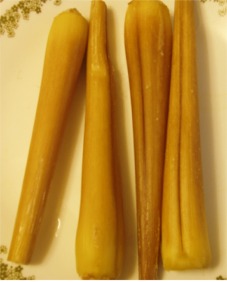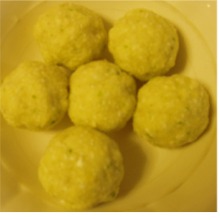Panang kizhangu Recipes
When the seedling is removed from the soil, it cleaned free from soil and the covering layer of sheath is removed. Then the resulting kizhangu is washed and boiled until it is well cooked. This gives the boiled version. (see below for the roasted version)
Kizhangu - Boiled version:

Panang Kizhangu Boiled and ready to eat
Remove the outer skin, wash well and boil in tall pot in water.
The whole of the kizhangu has to be covered with water. This takes some time.
To check if cooked only way is to take one out and taste it.
Once cooked remove from fire, strain the water and then it is ready to eat
This can be broken up into small pieces and eaten to get the somewhat sweet yam taste. As you break them up, remove the fibre and discard. It is delicious on its own. But it also can be eaten with other ingredients and made into a thuvaiyal.
Here is how it is done;
Thuvaiyal

Panang Kizhangu thuvaiyal made into balls
Ingredients:
Panang kizhangu 5
Green chillies 5
Coconut scraped and fresh Half cup
Salt to taste
Onions medium 2
Method:
Break the kizhangu into smaller pieces removing the fibres as they emerge.
Usually this is pounded in a mortar or Ural but can be ground together with green chillies, salt, coconut scrapings and onions in a grinder.
Until the mixture is somewhat mixed well.
The above (photo) had been chopped using a chopper - Use a chopper to chop and grind the onion, green chillies and coconut together until they are all mixed well.
Now add the pieces of kizhangu and grind to get a mixture.
Then take small amount of the mixture in the palm of your hand and make it into a ball of the size of a golf ball.
Repeat until all the mixture had been used up.
Now it is ready to eat.
Kizhangu - Roasted version:
In this version the cooking method is different.
The panang kizhangu with its sheath on is placed over embers in the stove, usually after all the cooking is completed.
They are constantly rotated to avoid burning and to get an even cooking.
Once cooked, the outer sheath is removed and it is ready to eat.
As with boiled version you can break this up into smaller pieces and eat or make a thuvaiyal as with boiled version.
This roasted version is much tastier than the boiled version.




